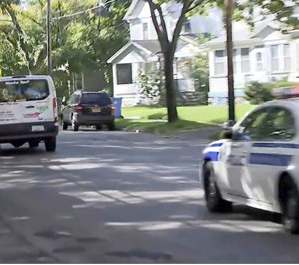| |
Technology is a key partner in the ongoing mission to improve officer safety. When you combine tech with proven policing tactics, you have a force multiplier that enhances safety for both officers and the citizens they serve.
Nowhere is this more necessary than during a pursuit, which is a high-risk event for both police and the public. While a dynamic pursuit is in progress, conditions change constantly and decisions have to be made in an instant.
 From driver simulation training that prepares cops ahead of time for the challenges of high-speed driving, to GPS tracking technology that enables officers to safely end a pursuit while still tracking a suspect, police leaders nationwide have a responsibility to incorporate tech into their police pursuit training and policies. From driver simulation training that prepares cops ahead of time for the challenges of high-speed driving, to GPS tracking technology that enables officers to safely end a pursuit while still tracking a suspect, police leaders nationwide have a responsibility to incorporate tech into their police pursuit training and policies.
Here is a laundry list of considerations and options to get you thinking in advance of your next pursuit about the decisions that will enable you to be a clear-thinking officer before, during and after the pursuit, as well as the technology that can assist in that decision-making.
Before every vehicle contact is attempted, anticipate a possible pursuit by:
- Possessing an absolute working knowledge of whether or not you are allowed by policy to pursue and if so under what conditions you must terminate.
- Training extensively in essential pursuit skills taught in emergency vehicle operations, pursuit management, technology deployment classes and driver simulation training.
- Wearing your body armor and utilizing your seat belt at all times.
- Obtaining — as often as possible — the plate number, and a description of the vehicle and its occupants prior to activating your lights.
- Paying attention to where the driver came from so that if necessary, you can later check the security cameras and witnesses to help determine who was driving the vehicle.
- Getting close enough before activating your lights to discourage flight. (Proximity concerns are altered when weapons are involved, however.)
During any pursuit:
- Remember, there is one law no one can break and get away with; that is the law of physics.
- Don't over drive your skills
- Show that you do care about going home at the end of your shift by driving with “due care.“ Hopefully you have trained in the application of these skills before the incident.
- Remember, your actions are the only element of the pursuit you are truly able to control.
After the suspect begins to flee:
- When your policy dictates or your commander orders it, you must terminate. Notify dispatch you are terminating the pursuit as you slow down. Shut your siren down when you reach a safe speed, then shut your overhead lights off. Pull over temporarily, and then you may resume patrol at the speed limit in the direction of the suspect's flight. Occasionally this will put you in a position to pull the driver out of his vehicle at the scene of his crash before he goes up in a ball of flames.
- Utilize available GPS technologies such as StarChase, which allows an officer to “tag” a fleeing vehicle and track a vehicle via GPS even after the pursuit is terminated or OnStar, which can track and slow vehicles to an idle speed.
- If your policy allows pursuits, ask this question, “Am I pursuing them because they are dangerous, or are they dangerous because I am pursuing them?” The answer to this question will help you decide personally whether to continue or terminate the pursuit. You might also ask yourself when it gets too crazy, “Is this worth dying for?”
- When you catch yourself shouting into the mic, perform autogenic breathing, while deliberately keeping yourself focused and calm. Breathe in through the nose slowly, hold and then out through the mouth slowly pushing the breath out with the muscles in your abdomen and repeat. Consciously make certain your transmissions are as calm and understandable as possible as you pass along the vehicle description, direction of travel, and speed.
- Break up the natural occurrence of tunnel vision by deliberately scanning for hazards to the left and right, which is essential to do during a pursuit anyway.
- If the vehicle is a stolen vehicle known to be equipped with OnStar, you can request that the dispatcher contact OnStar to remotely slow the vehicle and then disable the engine, thus terminating the pursuit.
After the driver of the fleeing vehicle comes to a stop but chooses to remain in the vehicle:
- Resist the impulse to bull rush. If you rush in, everyone will rush in. If you slow the action down, everyone will slow down.
- Transition to a high-risk stop.
- Whenever you make contact with the suspect, control your emotions. Remember the words of Eldon Mueller, “The man who angers you conquers you.”
After the driver stops but refuses to exit the vehicle and may be armed:
- Treat the situation like any other armed and barricaded suspect. Contain the suspect and call out the people with the shields and the armored vehicle who have trained often for such a circumstance.
- Maintain your cover and continue to communicate in an effort to call him out.
After you discover adrenalin has carried you to the driverís side of the car and the driver seems to be cooperative:
- Resist the temptation to yank the suspect out of the car with your weapon in hand. This may result in you unintentionally arriving to the right of “BANG!”
- Keep his hands in view.
- Order him to slide out of the vehicle face down, palms on the ground until he is in a prone position.
After you find adrenalin has carried you to the driverís side of the vehicle and the suspect is resistive:
- Make certain there are no weapons in their hands and within their reach.
- Effect a “car take-out” technique, which are compliance techniques coupled with joint manipulations to effectively remove resistive suspects from vehicle. Hopefully, you have trained in the application of these skills before the incident.
After a fleeing suspect slows and suddenly leaps out of a vehicle and flees leaving it in gear:
- Determine if the rolling vehicle is an imminent threat to other drivers. If so attend to the vehicle first.
- If the vehicle is not a threat, you may attend to the suspect first.
After a suspect comes to a stop and flees on foot the primary officer has to decide, “Do I set up a perimeter, or do I pursue?” Option one, if you choose to pursue on foot, you must:
- Immediately and constantly assess the suspect's hands and gait to determine if he might be holding something like a weapon in his hand or tucked in his belt.
- Watch the hands throughout the pursuit for the tossing of contraband, fruits of a crime or the act of acquiring a weapon.
- Take note of his clothing and physical description especially his footwear, for later identification. (They don't change/discard footwear.)
- Approach every corner by “cutting the pie” as if he is laying an ambush.
- Throughout this pursuit, radio your circumstance, location and direction of travel. Consciously control your breath.
- If the suspect flees into a residence or building, remember these words: “Suspects do not run to where your friends and weapons are, they run to where their friends and weapons are.” Stop and set up a perimeter to hold him in place until you can orchestrate a legal arrest.
- Remember, the act of fleeing an officer is not a capital offense. You can't use deadly force unless the fleeing suspect's escape poses an imminent threat of death or great bodily harm to the community at large.
After the suspect flees the vehicle, you also can consider option two:
- Determine the suspect's direction of travel.
- Arrange through transmissions to cordon off the area.
- Call for a K-9, and standby to prevent the track from being disturbed.
After the suspect flees on foot but leaves passenger(s), you may instinctively pursue the driver, or you may choose to stay with the vehicle and passengers, because:
- The passenger(s) often can identify the escaping driver.
- Passenger(s) may be accomplices in the driver's crimes and be the proverbial bird(s) in the hand.
- There is often evidence of whatever crime the driver was involved, left in the vehicle.
After the suspect you have chosen to pursue on foot disappears:
- Immediately attempt to cordon the area.
- Realize criminals will often hide the moment they believe they have lost their pursuing officer.
- Get some back-up and conduct a thorough, cautious search of the immediate area of the last sighting for that is often where they can be found hiding.
- Watch for vehicles circling since they may be friends who have been called to the scene by the suspect.
- If you do not locate the suspect, consider leaving officers hidden in the area for a time watching for the suspect to re-surface.
After a pursuit is terminated, or a suspect is lost the determined officer will:
- Continue with a follow-up investigation.
- Use the registration information, witness statements and passenger statements to locate the suspect hours, days or even months after the pursuit. In one such instance, the suspect parked his vehicle in front of his house and exited thinking he was literally “home free.” He was heard laughing with a friend about how he “ditched the cops.” The pursuing officer and his partner were waiting in the shadows and, to the suspect's shock, took him into custody
Conclusion
For the active street officer, it is imperative that when a violator chooses to engage in mindless flight, that officer's brain is totally engaged before, during and after the pursuit to ensure the end result is a pursuit of excellence.
Lt. Dan Marcou is an internationally-recognized police trainer who was a highly-decorated police officer with 33 years of full-time law enforcement experience. Marcou's awards include Police Officer of the Year, SWAT Officer of the Year, Humanitarian of the Year and Domestic Violence Officer of the Year. Upon retiring, Lt. Marcou began writing. He is a co-author of “Street Survival II, Tactics for Deadly Encounters,” which is now available. His novels, “The Calling, the Making of a Veteran Cop,” “SWAT, Blue Knights in Black Armor,” “Nobody's Heroes” and “Destiny of Heroes,” as well as his latest non-fiction offering, “Law Dogs, Great Cops in American History,” are all available at Amazon. Dan is a member of the PoliceOne Editorial Advisory Board.
|
|
